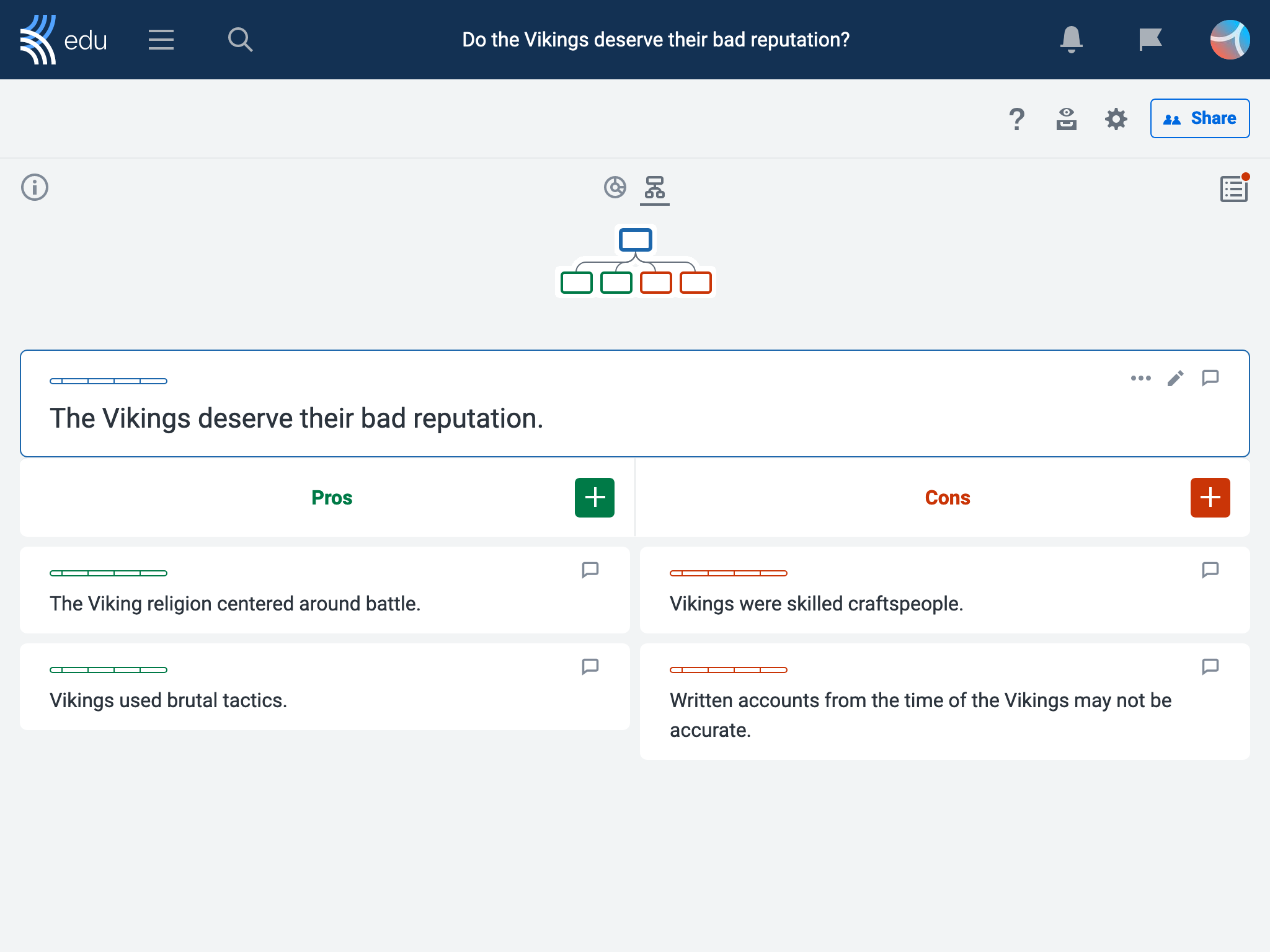Are your students lacking in logic and rotten at reasoning? Perhaps they simply don’t know the difference between the two! The terms logic and reasoning are often used interchangeably, but have unique characteristics.
Logic and reasoning are important components in critical thinking, which is a lifelong, 21st-century skill for students in and out of the classroom. Find out how you can use Kialo Edu discussions to help your students explore the difference between logic vs. reasoning — completely free!
What is logic?
Logic is a science used to study the validity of arguments through the use of a clearly defined set of rules. Think of logic as a map, guiding you through the maze of an argument. It is not concerned with the truth of an argument, but simply whether it follows the rules of validity.
How does logic make an argument valid?
In the context of logic, an argument is a series of statements: One statement is the conclusion and all other statements are the premises. The rules of logic determine the validity of these statements.
Let’s examine syllogisms as an example. A syllogism is a deductive argument with two premises and a conclusion, such as this one:
Premise 1: There were 10 cookies in the jar.
Premise 2: There are currently 9 cookies in the jar.
Conclusion: Thus, 1 cookie is missing.
This is a valid argument — the truth of the premises guarantees the truth of the conclusion. Unfortunately, it can’t help us track down the cookie thief!

Let’s apply the rules of logic to another syllogism:
Premise 1: All pigs can fly.
Premise 2: Peppa is a pig.
Conclusion: Thus, Peppa can fly.
Believe it or not, this is a valid argument in terms of logic, because it follows the rules! If we accept the premises as true, the conclusion must also be true.
However, this is definitely not a sound argument, as it is not factually accurate — unless there have been recent evolutionary developments in the porcine world!
Let’s take a look at a final example:
Premise 1: All dogs are warm-blooded.
Premise 2: All cats are warm-blooded.
Conclusion: Thus, all cats are dogs.
Here, the premises are true, but they do not support the conclusion, making this an invalid argument — it does not follow the rules of logic.
So, we can conclude that logic is a framework used to evaluate the validity of an argument.
What are the benefits of teaching logic to students?
Your students may not grasp every concept you teach them, but hopefully they do recognize that all cats are not dogs. So, why teach them the rules of logic?
An understanding of logic helps students to organize information, make connections, and draw conclusions — all key skills within critical thinking. Applying a set of rules allows students to evaluate arguments objectively, distinguishing between truths and falsehoods and identifying common fallacies. Knowledge of the rules of logic also aids students in constructing their own strong oral and written arguments.
Best of all, the ability to apply the rules of logic is a transferable skill that students can use across the curriculum and in their future careers.
What is reason?
Reasoning builds on the rules of logic and is defined as the action of thinking about something in a logical, sensible way. It can be likened to solving a puzzle, as it involves piecing together information, observations, and experiences to make an inference or draw a conclusion.

While logic is an external framework of predetermined rules, reasoning is an internal process that can be influenced by knowledge and beliefs. Reaching a conclusion involves individual interpretation of evidence through the lens of one’s own experience.
What are the benefits of teaching reasoning to students?
Teaching students how to reason helps to extend their understanding of logic. In our earlier syllogisms, students could use logic to conclude that Peppa can fly, but reasoning is what allows students to prove that she cannot — at least, not without the help of Miss Rabbit’s helicopter!
Reasoning equips students with the tools to think critically, make a decision, or solve a problem, all higher-order skills that can be applied across the curriculum. Through practices in reasoning, students learn to incorporate prior knowledge and experience into decision making, to consider a range of viewpoints, and to use evidence to support judgements. This combination leads students to reach informed conclusions.
How can students apply logic and reasoning in a Kialo Edu discussion?
Kialo Edu discussions are designed to train critical thinking, a key aspect of reasoning, and developing an argument map offers a great opportunity to explore the validity of arguments.
The thesis acts as the conclusion of an argument. For example, take the thesis “The Vikings deserve their bad reputation.” The premises then take the form of branching claims developed underneath the thesis.
Here, the premises could be “The Vikings used brutal tactics” followed by “The Vikings are said to have performed the blood eagle torture method.” We have not yet established whether these claims, or premises, are accurate, but they do follow the rules of logic to form a valid argument.

To ensure that claims are factual, students employ reasoning skills to research and evaluate evidence to support their claims. Then they simply need to link evidence to their claim and add a relevant quotation if needed. Students can continue to reason through the argument by composing further supporting and contrasting claims.
For example, in our Viking discussion, students may reason that much of the written evidence on Viking brutality originated from the Anglo-Saxons. The result is a well-reasoned argument map that follows the rules of logic and is supported by evidence.
We hope that the differences between logic and reasoning are now clear, and you feel confident teaching them to your students! To check your understanding, let’s finish with a syllogism:
This article explains the difference between logic and reasoning.
You have read this article.
Thus, you know the difference between logic and reasoning!
Let us know how you’re teaching logic and reasoning in your classroom — you could even create your own syllogism! Send them to us at feedback@kialo-edu.com, or post them on any of our social media platforms.
Want even more ideas on teaching debate and argumentation to students? Explore our collection of expertly-crafted resources!

